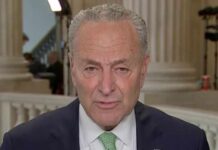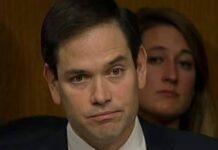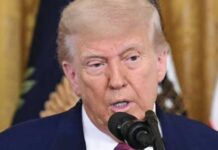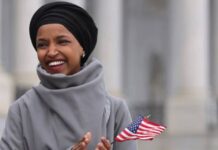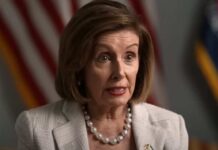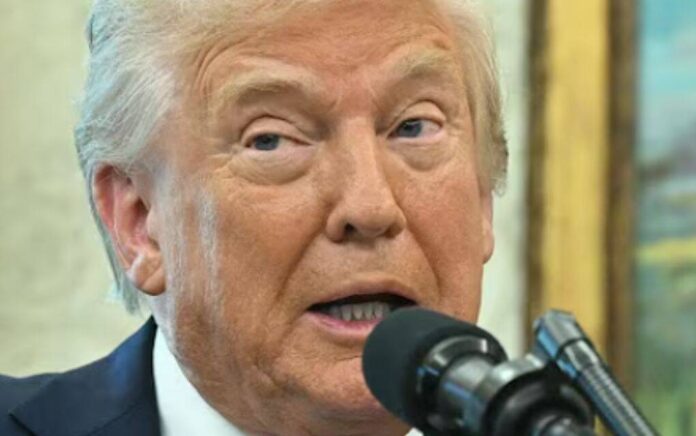
A major issue is brewing for the Trump admin. The outcome will change everything.
And President Trump is at a breaking point with this consequential decision to make.
Trump’s Iran Nuclear Strategy Up In The Air, Reports Suggest
The Trump administration’s recent flip-flopping on Iran’s nuclear program raises serious concerns about whether it is repeating the mistakes of the Obama era. Initially signaling a willingness to allow limited uranium enrichment under strict oversight—much like the framework of Barack Obama’s Joint Comprehensive Plan of Action (JCPOA)—the administration abruptly shifted to a zero-tolerance stance. This vacillation suggests a deeper internal struggle within the administration and casts doubt on whether a verification-based approach, as pursued by Obama, can effectively curb Iran’s nuclear ambitions. History suggests it cannot, and the Trump administration risks stumbling down a familiar, flawed path.
The Obama administration’s JCPOA, implemented in 2015, aimed to limit Iran’s uranium enrichment to 3.67% purity for civilian purposes while imposing international oversight. Critics, including Trump himself, lambasted the deal for its sunset clauses, which allowed restrictions to expire over time, and its inadequate monitoring mechanisms. These shortcomings, conservatives argued, enabled Iran to advance its nuclear capabilities under the guise of compliance. Trump’s campaign rhetoric promised a tougher stance, yet recent statements from U.S. Special Envoy Steve Witkoff echoed the Obama-era approach before pivoting to a hardline position, leaving observers questioning the administration’s coherence.
On April 14, Witkoff suggested the U.S. might tolerate Iran’s uranium enrichment for civilian use, provided it remained within the 3.67% purity threshold. This proposal alarmed experts who saw parallels to the JCPOA’s framework. “This is the Obama JCPOA repackaged,” Mark Dubowitz, CEO of the Foundation for Defense of Democracies (FDD), told the Jerusalem Post. “Did we really leave it in 2018 just to return to it in 2025 – especially now, when we have maximum leverage? I’m curious how this version avoids the same fatal flaws that made the 2015 deal so dangerous.” The resemblance to Obama’s deal sparked immediate backlash from hawkish factions within Trump’s orbit.
Just one day later, on April 15, Witkoff reversed course, declaring that Iran must not enrich uranium at any level—a stark departure from his prior comments. This abrupt shift points to a broader tug-of-war within the administration. “It’s the neoconservatives in the administration, people like Marco Rubio and people close to the president, like Lindsey Graham and Tom Cotton, are trying to steer him down a blind alley at the end of which is war with Iran,” Justin Logan, director of defense and foreign policy studies at the CATO Institute, told reporters. The hardliners’ push for zero enrichment sets a high bar that could lead to either war or Iran’s unchecked nuclear advancement.
The Obama administration’s experience with the JCPOA offers a cautionary tale. Despite its intent to constrain Iran, the deal allowed the Islamic Republic to maintain significant nuclear infrastructure while reaping economic benefits from sanctions relief. By the time Trump withdrew from the JCPOA in 2018, Iran had bolstered its nuclear expertise and regional influence. Under President Joe Biden, Iran further capitalized on relaxed enforcement, amassing $37 billion in oil revenues in 2021, $54 billion in 2022, and $53 billion in 2023. Biden’s failure to revive the JCPOA, which he declared “dead” in 2022, left Iran’s enrichment activities largely unchecked.
Witkoff’s initial proposal to enhance International Atomic Energy Agency (IAEA) monitoring and eliminate sunset clauses appeared to address some of the JCPOA’s flaws. However, the rapid pivot to a zero-enrichment demand suggests that diplomatic pragmatists within the administration—such as Vice President JD Vance, Defense Secretary Pete Hegseth, and Director of National Intelligence Tulsi Gabbard—are losing ground to interventionists. Sources told the New York Times that Trump was dissuaded from military strikes on Iran last month, indicating that restraint-minded officials still hold some sway. Yet, the administration’s inconsistent messaging undermines confidence in its ability to negotiate effectively.
Hawkish conservatives often point to the “Libyan model” as an alternative, where Muammar Qaddafi voluntarily dismantled Libya’s nuclear program in 2003 in exchange for sanctions relief. This approach, however, assumes Iran’s willingness to capitulate entirely—a questionable prospect given its decades-long investment in nuclear technology and regional power projection. The zero-enrichment stance, while appealing to hardliners, risks boxing the U.S. into a corner where military conflict becomes the only viable option if Iran refuses to comply.
Restraint-minded experts argue that dismissing a verification-based approach outright is misguided. Trita Parsi, executive vice president of the Quincy Institute for Responsible Statecraft, shared with reporters that interventionists are leveraging comparisons to Obama’s deal to sabotage diplomacy. “I think there’s a desperation amongst those who wanted him to go down the path of the Israelis favor, to try to shame him into not pursuing the verification model,” Parsi said. “It’s easier for them to try to make these arguments of claiming that this is too similar to Obama’s deal, and try to shade Trump away from that, rather than through the attraction of their own arguments.”
The administration’s mixed signals reflect deeper indecision. “I think it’s been just a feature of the administration on this issue in which at times, there’s been either imprecise or contradictory messaging, which may reflect that some of these issues have not been entirely settled inside the industry,” Parsi has said. This lack of clarity could embolden Iran, which has historically exploited diplomatic ambiguity to advance its nuclear program while maintaining plausible deniability.
The stakes are higher now than during Obama’s tenure. Iran’s economic recovery under Biden has strengthened its negotiating position, and its enrichment capabilities have advanced significantly since the JCPOA’s collapse. A verification-based approach, even with enhanced oversight, may struggle to contain a more resilient and defiant Iran. The Obama administration’s failure to enforce robust inspections allowed Iran to skirt restrictions, and there’s little evidence that a similar strategy would fare better today.
Hardliners argue that anything short of total dismantlement invites Iran to continue its nuclear brinkmanship. Logan’s warning is stark: “If you say our goal is to get zero enrichment in Iran, then you’re either going to let Iran get nuclear weapons or you’re going to go to war with Iran, or both.” This binary choice underscores the peril of abandoning diplomacy entirely, but it also exposes the limitations of relying on verification alone.
The Trump administration’s internal divisions mirror the broader challenge of confronting Iran’s nuclear ambitions. A return to Obama’s verification model risks repeating past failures, as Iran has proven adept at exploiting loopholes and weak enforcement. Yet, the hardline push for zero enrichment could precipitate a crisis that diplomacy might avert. The administration’s ability to reconcile these competing impulses will determine whether it can forge a path that avoids both appeasement and catastrophe.
Iran’s nuclear program has long been a geopolitical flashpoint, and the Trump administration’s early missteps suggest it is grappling with the same dilemmas that plagued its predecessors. The JCPOA’s collapse demonstrated the pitfalls of a flawed verification regime, and Iran’s subsequent advancements have only raised the stakes. Witkoff’s contradictory statements may reflect a lack of consensus, but they also signal an opportunity to chart a new course—one that learns from Obama’s mistakes rather than repeating them.
The administration must decide whether to pursue a diplomatic framework that can withstand Iran’s history of evasion or commit to a confrontational stance that risks escalation. The Libyan model, while appealing to hawks, is unlikely to resonate with a regime that views nuclear capability as a cornerstone of its security. A verification-based approach, if pursued, would require unprecedented rigor and enforcement to succeed where Obama’s deal failed.


